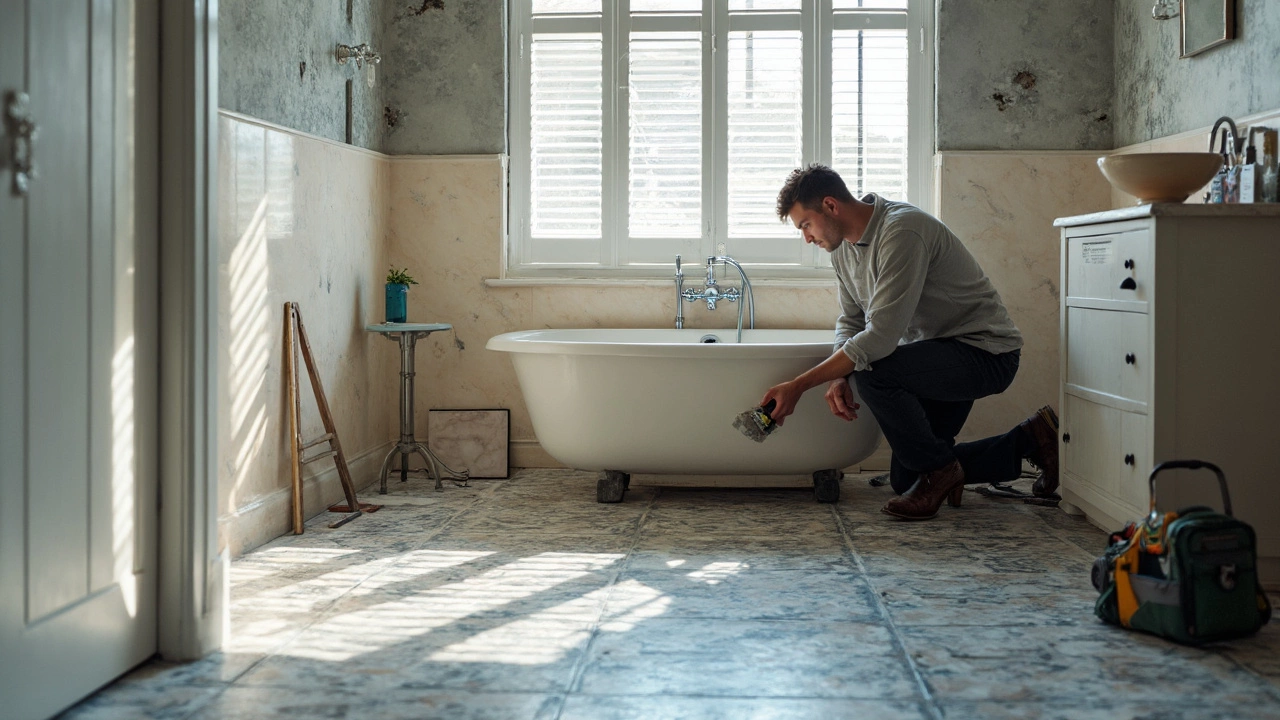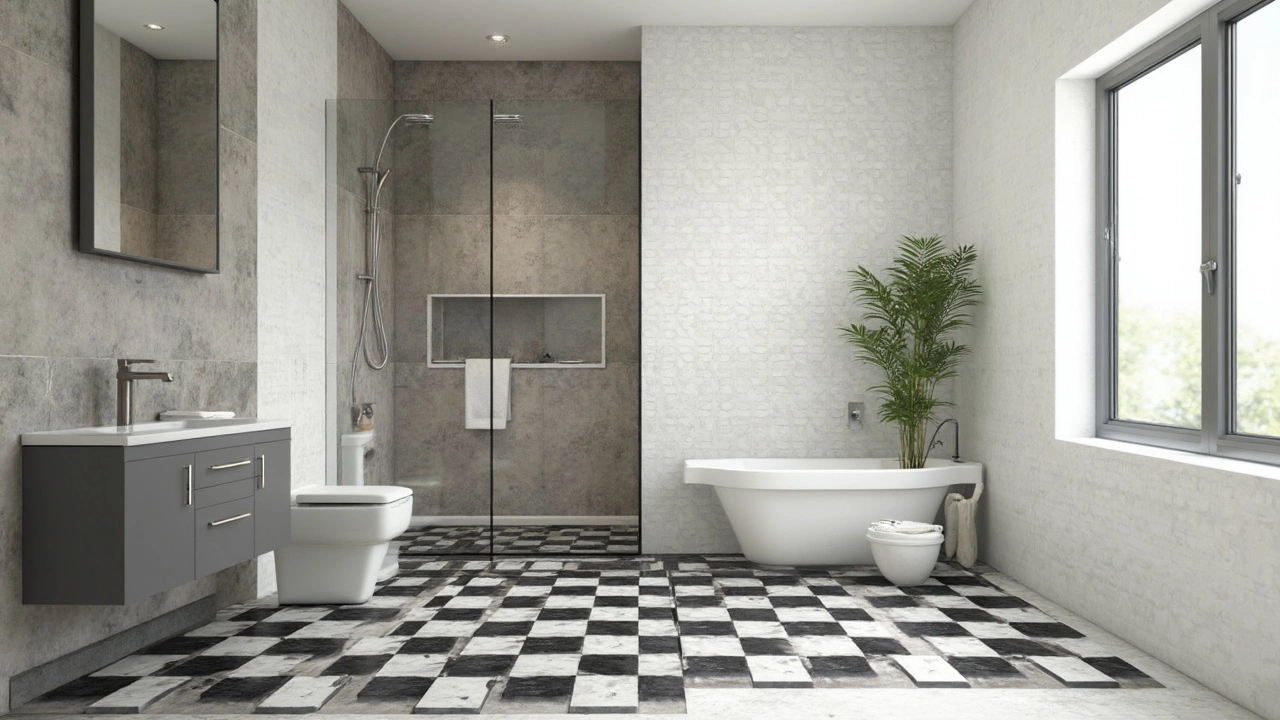Bathroom Remodel: Walls or Floor First?
 Mar, 15 2025
Mar, 15 2025
When you're staring down a bathroom remodel, the question of whether to start with the walls or the floor can feel puzzling. Sure, it's not as glamorous as picking out that trendy sink or the perfect bathtub, but it can affect how smoothly everything goes.
Let's start with the floor. Choosing to tackle this first can often mean fewer headaches down the road, especially regarding alignment and stability. Think about it: laying down a sturdy, water-resistant floor before anything else means you've got a solid foundation. Plus, it lets you see how the rest of your elements will contrast or complement your floor choice.
- The Basics of Bathroom Remodeling
- Why Flooring Matters
- Painting or Tiling Walls
- Workflow Efficiency
- Common Mistakes
- Expert Tips for Success
The Basics of Bathroom Remodeling
Remodeling a bathroom is more than just picking colors and fixtures. It's about making space practical, efficient, and yes, a bit stylish if you can manage it. But here’s where the rubber meets the road, starting with a solid plan is crucial.
Set Your Budget
Without a clear budget, costs can skyrocket quickly. Decide how much you're willing to spend — and stick to it. Know the costs for major elements like a new floor, fixtures, and labor.
Plan the Layout
Think about where everything fits best. Sometimes, rearranging the layout so the toilet isn’t the first thing you see can do wonders. Keep plumbing locations in mind. Moving them can be costly!
Choose the Right Materials
Selecting durable and water-resistant materials is key, especially for floors and walls. Porcelain tiles are a popular choice, offering a blend of style and durability.
Permits and Regulations
You might need a permit for your remodeling project, especially if you're moving plumbing or electrical outlets. Be sure to check local regulations to avoid any surprises.
Decide on Features
Consider what features you want. Do you need more storage? A big shower or a fancy bidet? These decisions will impact your budget and layout, so think them through early.
Project Timeline
Set a realistic timeline. Rushing might lead to mistakes, so give yourself or your contractors the time needed to do things right.
Now, you’re armed with the bathroom remodeling basics. With these foundations in place, your journey into picking whether the walls or floor come first becomes a much easier decision.
Why Flooring Matters
Let's dive into why getting your bathroom remodel floors right can make or break your entire renovation. Seriously, it's more than just something to walk on. It sets the tone for durability, design, and function right from the get-go.
Durability and Function
First off, durability should be top of mind. Bathrooms are, by nature, wet places. That means picking a floor that can withstand moisture is non-negotiable. Tiles, for example, are popular because they're tough against water and last a lifetime if installed correctly.
Also, remember that the flooring choice dictates the vibe. A serene spa-like atmosphere? Go with large, matte stone tiles. Looking to keep it classic? Maybe vinyl tiles that mimic wood are your jam. The floor is your canvas!
Foundation for Other Installations
A sturdy floor means you have a steadfast base for everything you put on top of it. Whether it’s vanities, a full bathtub, or any quirky feature you want, a firm foundation is key. Getting the floor in first not only brings stability but might save you the pain of resizing cuts or readjusting levels as you continue.
Aesthetic Flow
The look and feel of your bathroom all flow from the floor. Starting with it lets you better visualize your space. Decisions about wall tiling or paint become simpler because you’ve established a baseline texture and color palette.
| Common Flooring Material | Water Resistance Rating |
|---|---|
| Ceramic Tile | High |
| Porcelain Tile | Very High |
| Vinyl | High |
| Hardwood | Moderate |
So when planning out your bathroom remodel, don't underestimate the power of starting with the right floor. Pick the right material, lay it right, and you'll have set a rock-solid foundation (literally) for everything else to follow.
Painting or Tiling Walls
Deciding between painting or tiling the walls is a big step in any bathroom remodel. Each option has its perks and things to watch out for, and your choice might depend on budget, style, or practicality.
When to Choose Tiling
Tiling walls can offer a durable and waterproof surface, which is super handy in high-moisture areas like a bathroom. Tiles can protect the walls from water damage better than paint. They're also easy to clean, making them a favorite for many homeowners. Plus, with endless design options, tiles let you add personality to your space, be it through patterns or unique textures.
It's worth noting that tiling can be a more expensive and time-consuming process compared to painting. But if you're looking for something that's long-lasting, it's often a sound investment.
When to Go for Paint
Painting, on the other hand, can offer flexibility and simplicity. If you're on a tight budget or timeline, paint can quickly transform a space with minimal fuss. It's perfect for areas where moisture isn't as big of a concern, like ceilings or powder rooms.
One bonus of painting is that it's easy to change the look down the line. If you want a fresh vibe every few years, a couple of coats will do the trick.
Combining Both
Sometimes the best approach is a mix. Use tiles in areas with the most splash risk, like around the shower or sink, and paint other, less exposed walls. This hybrid approach gives you the best of both worlds: the protection of tiles and the versatility of paint.
When planning, remember to choose moisture-resistant paints made especially for bathrooms. This can prevent peeling and damage over time.
When you break it down, whether to paint or tile really comes down to what suits your needs and what vibe you're going for. Make sure to weigh the pros and cons to see what works best for your bathroom renovation.

Workflow Efficiency
Getting your bathroom remodel off on the right foot is all about nailing the workflow. You want this process to be as seamless as possible, and figuring out whether it's walls or floors first can make a world of difference in efficiency.
Starting with the floor tends to be a smart move for minimizing mess and maintaining a smooth progression. Here's why: if you're laying new tiles, starting from the ground up gives you a straightforward base to align everything else against. This can prevent annoying adjustments later. Plus, finishing the floor first means you won’t have to worry about dropping tools or materials onto a fresh paint job or touch-ups later.
Laying the Groundwork First
By getting the floor down initially, you've set the stage for everything else to fall into place. Installing drains, fixtures, and cabinets post-flooring ensures these elements sit correctly and reduces the risk of damaging your new tiles or floor finish.
When Walls Take Priority
There are cases where walls might take priority, especially if your renovation involves significant plumbing or electrical work that requires opening walls. In such instances, completing intricate wall tasks first prevents damage to a newly laid floor, saving time and hassle long-term.
Time Management Tips
- Plan Ahead: Have your materials and tools ready before starting to prevent interruptions.
- Preschedule Work: If you're hiring contractors, align their tasks with yours for efficiency.
- Cushion Your Timeline: Always allow extra time for unforeseen delays. It’s better to finish early than stress about running late.
By prioritizing workflow efficiency in your bathroom renovation, you not only save time, but also prevent cost overruns and keep your project on track.
Common Mistakes
Remodeling a bathroom isn’t just picking pretty tiles. People often make some avoidable blunders when deciding whether to tackle walls or floor first. Let's dive into those pitfalls and how to dodge them.
Rushing the Process
Alright, let’s start with speed. Everyone wants their project done yesterday, but rushing can lead to costly mistakes. John Smith, a reputable contractor from DIY Experts, said,
"Taking your time to plan and execute each step is invaluable. Remember, it's your home, not a sprint."
Ignoring Material Compatibility
One thing folks often overlook is whether the materials they've chosen for the bathroom remodel actually work well together. Mixing incompatible materials can lead to ugly grout lines and cracks down the line. For instance, pairing non-porous tiles with a substrate that expands a lot isn't ideal and can cause headaches later on.
Poor Measurements
Another biggie is not measuring the area correctly. Incorrect measurements lead to wasted materials and sometimes even the need to reorder. Always double-check the dimensions before starting work! A great rule of thumb is measuring twice and cutting once.
Neglecting Waterproofing
Bathrooms are wet zones. Seems obvious, right? Yet, some renovators skip proper waterproofing steps. This mistake can be catastrophic long-term, leading to mold issues and water damage. Always ensure that your bathroom floor is adequately waterproofed before considering it ready for use.
Budget Failures
Everyone dreams big, but budget realistically. Going all-out on high-end finishes without a backup fund can halt your project midway. It's wise to keep a 15% budget buffer for unexpected expenses or changes.
| Common Mistake | Impact |
|---|---|
| Rushing | Errors and cost overruns |
| Ignoring compatibility | Poor aesthetics and defects |
| Bad measurements | Waste of resources and time |
| Skipping waterproofing | Long-term damage issues |
| Poor budgeting | Project halts and compromises |
Steering clear of these missteps can save you time and money and help create a bathroom that both looks and functions amazingly. So take a pause, plan ahead, and watch as your dream bathroom comes to life without the agony of unnecessary mistakes.
Expert Tips for Success
Pulling off a bathroom remodel like a pro requires some savvy knowledge and a knack for smart decision-making. Here are some expert tips to help you succeed—whether you're starting with walls or flooring, or vice versa.
1. Plan Your Budget
The key to a successful bathroom renovation is planning your budget wisely. This includes materials, labor, and a buffer for unexpected expenses. Remember, going overboard on one element might leave little room for others.
2. Choose Materials Wisely
Selecting the right materials for your bathroom remodel is crucial. For floors, go for moisture-resistant options like ceramic tiles or vinyl. Walls can benefit from tiles too, or consider a high-quality paint. Always opt for durability over aesthetics alone.
3. Sequence Your Tasks
When it comes to deciding on walls or floor first, think about workflow efficiency. Start with the task that demands more drying time, such as tiling the floor, and then move to the walls. This maximizes downtime effectively.
4. Hire Professionals
If DIY isn't your forte, consider hiring professionals. They bring valuable experience and can foresee potential issues. Be clear with your vision and budget when talking to them.
5. Be Mindful of Ventilation
Good ventilation is paramount, especially if you're opting for steaming hot showers or freestanding tubs. Talk to your contractor about installing exhaust fans or vents efficiently.
6. Take Measurements Seriously
Double-check measurements for custom fixtures like countertops and toilets. A rule of thumb for every renovation job: measure twice, cut once.
Here's a quick look at material options for different elements of your bathroom:
| Element | Recommended Material |
|---|---|
| Floor | Ceramic Tile, Vinyl |
| Walls | Tile, Waterproof Paint |
| Countertops | Quartz, Granite |
Following these guidelines won't only make your bathroom renovation process smoother but might save you from future headaches too. Happy remodeling!
